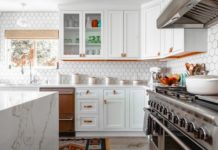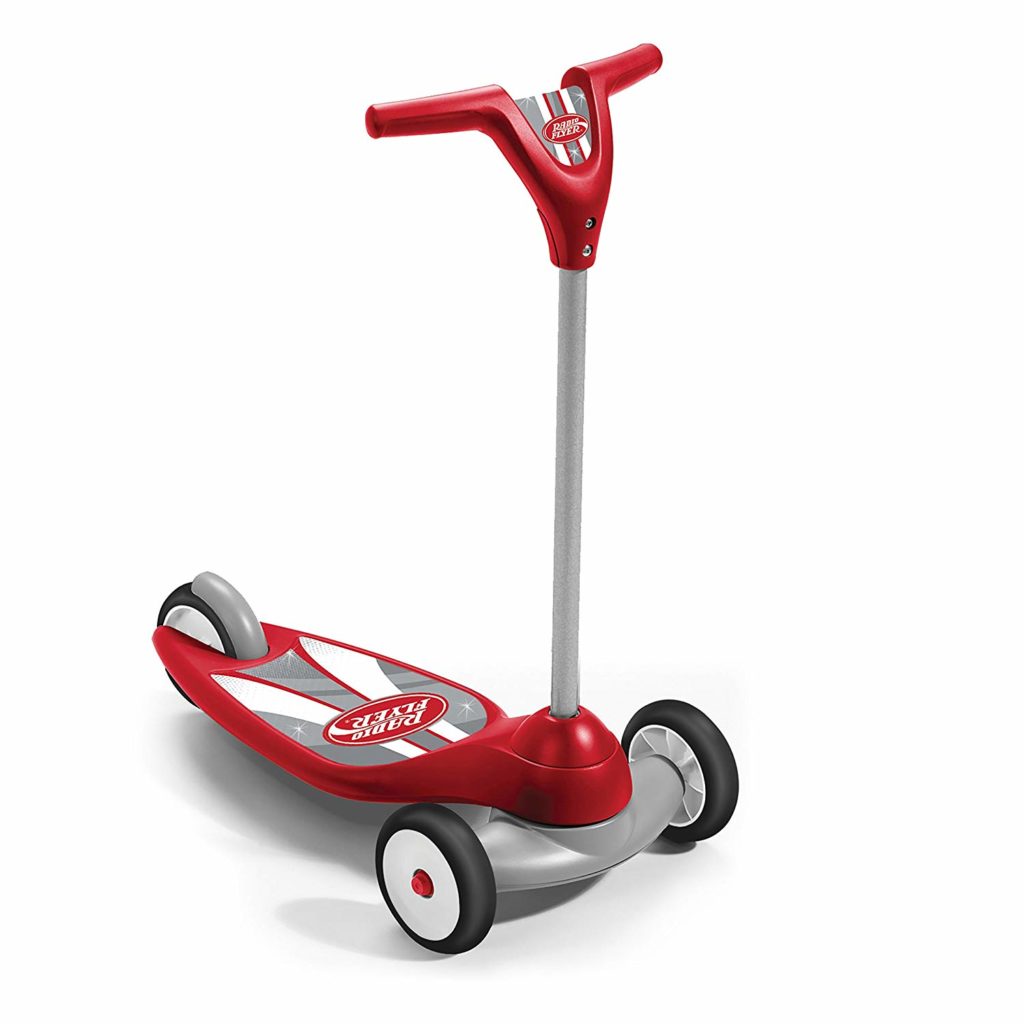With so many fun things that children get to do in the digital world, it can be hard to get them away from the screens to enjoy the outdoors. You’ve got to offer them something more exciting than the games they get to play on their phones, iPads, and computers – scooters! Aside from getting them outdoors, scooters for kids are excellent tools for promoting exercise and good old fashioned fun. The question is, what kind of scooter should you get? With so many options out there, it’s easy enough to feel overwhelmed. Not to worry though. We’ve got just the list for you. According to our research, below are the 10 best scooters for kids of every age:
Three-wheeled Scooters:
Radio Flyer My 1st Scooter
The Radio Flyer My 1st Scooter is a perfect starter scooter (as the name already suggests) for your toddler. It features an extra wide front base for increased stability which tapers at the back so your child won’t kick the scooter accidentally while pushing it off. The best thing about this scooter is that it is a bicycle-turn type instead of the lean-to-steer system which is perfect if you want to start your kid off slowly. He can learn about balance and coordination first before tackling the steering part. However, this is entirely made out of plastic, including the wheels which means this doesn’t roll as well as rubber. Then again, you won’t have to worry about your 2-year old speeding off into the sunset. The handlebar isn’t height adjustable. Also, the steering is a bit stiff which a 2-year old might find difficult to turn.
- good balance
- easy to use
- doesn’t go fast
- handlebar is not adjustable
- made entirely out of plastic
- stiff steering
Den Haven Deluxe 3 Wheel Glider
This 3-wheeled scooter from Den Haven is the perfect choice for little beginners and by that, we mean as young as 2 years old but not more than 5 who are 40 pounds or lighter. It features an aluminum frame, and adjustable T locking handlebar, and comfort grip pads. The large aluminum reinforced brake pedal is easy to use while the wheels light up to the delight of little ones. One great thing about this starter scooter is that it’s incredibly cheap so you won’t get irritated when you need to buy a new one because he’s outgrown this one. Or if he loses interest in the scooter far too quickly. However, because of the low price, quality isn’t up to par as other starter scooters. It’s mostly made out of plastic which will break off if you’ve got a rough rider on your hands. Plus, there are no replacement parts available, particularly for the brake piece. Also, this scooter is the lean-to-steer type which might not be easy for little kids to learn.
- Great price
- Comfort grip pads
- Perfect for little beginners
- Durability issues
- No replacement parts
- Lean-to-steer type may be difficult for some little kids
Globber Primo 3-Wheeler
If you want to teach your little one how to ride a scooter, the Globber Primo 3-Wheeler is a great choice. It features a button that locks the steering which enables your child to focus on learning how to balance first before tackling the lesson of lean-to-steer. The deck is made of hi-impact PP with an anti-slip texture and reinforced with a steel plate for durability. The aluminum t-bar handlebars are adjustable from 26.5” to 31”. Coupled with the fact that the max weight limit is 110 lbs, you can be sure that your kid will be able to use this for at least a few years before graduating to a two-wheeler. The big polyurethane wheels in the front provide great stability as well as smooth riding over hard surfaces. However, the back wheel easily gets worn down. Also, the brake piece (the one you step on) tends to break off and costs $13 to replace.
- Locks steering system
- Anti-slip texture on deck
- Adjustable height
- Rear wheel gets easily worn down
- Complaints on brake piece falling off
Micro Mini Deluxe Kick Scooter
The Micro Mini Deluxe scooter is a popular choice among parents and kids ages 2 to 5. It has a weight capacity of 75 lbs and an adjustable T-bar (ranging from 17″ up to 25″ from the deck) so your child can continue to use it as he grows. The low-to-the-ground deck increases the stability of the scooter. Did we mention that its a flexible fiberglass reinforced deck with shock absorption? Its increased durability will ensure that it’ll still be a favorite toy of your little one for years to come. The scooter is even certified by CPSC so you can feel secure that your child is safe using this toy. While this is not foldable, we love that you can pop out the handlebar from the deck and store it away or take it with you on family vacations. However, some kids may have a hard time learning the lean-to-steer concept. It is quite expensive for a starter scooter. And it’s a little too small for kids 7 and up.
- durable
- certified by CPSC
- adjustable handlebar
- lean-to-steer type may be hard for toddlers
- a bit pricey
- too small for kids ages 7 and up
Micro Maxi Kick Scooter
If the Micro Mini Deluxe is too small for your kid, you can go for the much bigger Micro Maxi which has a larger deck and a max weight of 110 lbs. The handlebar can be adjusted from 24 inches to 34 inches. The wheels are made of high quality PU and 120mm big. One thing that makes this entirely different from the Mini (aside from size) is that it feature 2 wheels at the back which are placed side-by-side so it appears as if there’s just one. The presence of the two wheels gives better braking stability to the scooter which is what you’d want for a starter scooter. The flexible chassis deck is perfect for carving and curving. You can even switch out the T handlebar for a joystick one (purchased as an accessory) if that’s what your kid prefers. Overall, the quality and build of the Maxi is great. However, it is even more expensive than the Micro Mini. Also, some parents reported that the red color faded really fast into pink.
- excellent quality
- better braking stability
- larger deck and higher weight limit
- very expensive
- red color fades to pink fast
Two-wheeled Scooters:
Razor A5 Lux Scooter
This two wheel foldable scooter is perfect for kids who’ve graduated from the three-wheeled type. The t-tube and deck are made of aircraft-grade aluminum and features extra large 200mm urethane wheels and a rear fender brake. The handle bars feature foam grips and are adjustable so this can be used even if your kid goes through a growth spurt. Plus, the max weight limit is 220 lbs so this scooter is a good investment because it’ll get years of use. The Razor A5 Lux also comes with a kickstand so your kid won’t be leaving it lying on the ground after he’s done. Even better, the scooter is foldable (in just a few seconds) and can be carried or stored away. However, it has no suspension so your child will feel the bumps on the road. The brakes uses friction to slow the wheel which becomes slicker when it rains. In short, this is not suitable for use in the rain.
- foldable
- adjustable handlebars
- large wheels
- no suspension
- not suitable for riding in the rain
Razor® A3 scooter
If your kid wants a smaller scooter, the A3 from Razor is worth checking out. While it may not have the same stability offered by the larger wheels of th A5, this one features 125mm inline-style urethane wheels with springless shock-absorbing system to provide you with a smoother ride. The A3 is also foldable and is much easier to carry around at only a little over 6 pounds. Plus, it comes with a wheelie bar design for tricks if your kid wants to try learning but isn’t too committed yet to go for a pro scooter. However, the height of the handlebar is too low (even at max height) for kids taller than 4 ½ feet. The foam grips don’t last that long. And folding the A3 doesn’t go as smoothly as with the A5. It’s considerably cheaper though so take that into consideration.
- lightweight
- wheelie bar design
- springless shock-absorbing system
- not for individuals over 50 inches tall
- foam grips don’t last long
- can be difficult to fold
Pro Scooters
Fuzion X-3 Pro Scooter
If your kid is asking for a pro scooter, the Fuzion X-3 is something to consider. It features an aircraft grade aluminum deck, high tensile steel V-bars, 100mm cast PU wheels, and Fuzion Metalized ABS Composite core wheels. It also comes with a nylon/steel fuzion custom flex brake and an IHC compression system. This is the perfect choice for entry level riders who want to start learning tricks and stunts. However, the grips aren’t that comfortable. The wheels are also easily worn down, especially on asphalt. The brake piece is also a bit on the flimsy side.
- affordable
- IHC compression system
- aircraft grade aluminum deck
- poor quality wheels
- brake piece is a bit flimsy
- grips aren’t that comfortable
Fuzion Z300
If your kid is on his way into teen territory and requires more action from his scooter than just going from one point to another, then the Fuzion Z300 Pro Scooter may be the upgrade he’s looking for. This pro scooter comes with a 23”H/22” W steel chromoly Vert riser bar plus 155mm extra-plus, extra wide Hex grips. The Chisel fork is made from sturdy steel with 100mm Dose 6061 Alloy Core Wheels with high rebound 88A PU and super-fast ABEC-9 Fuzion bearings. The 6061 T6 Aluminum deck is wider (4.25 x 19.5 inches) and features the Fuzion custom Triad nylon/steel brake. It also has a 3-degree top concave design and a flat bottom with rails which makes it perfect for grinding. In short, this is a pro scooter that won’t embarrass your kid at the skatepark. However, the handlebar isn’t adjustable so if your kid has a sudden growth spurt, this may become too short. It is also a little heavier compared to other pro scooters. And the grips aren’t very comfortable.
- Perfect for grinding
- Excellent quality
- Comes completely dialed
- Handlebar isn’t adjustable
- Little heavier than other models
- Grips aren’t very comfortable
Razor Pro RDS Dirt Scooter
The Razor Pro RDS Dirt Scooter isn’t exactly a pro scooter. It’s actually an off-roading scooter featuring heavy duty aluminum wheels and 200mm pneumatic tires with high traction and tread – perfect for tackling dirt. Other features of this off-road scooter is the tubular BMX style steel fork, rear fender brake, full grip tape, soft rubber grips, triple stacked headtube clamp, and a fixed riser Y-style handlebar. The max rider weight for aggressive riding on this baby is 120 lbs, 200 lbs for normal riding. However, this is only ideal for rough surfaces as regular pro scooters are still faster on smoother pavement. The handlebar can’t be adjusted – stays at 30 inches. And the tires need to be reinflated frequently.
- Off-roading scooter
- Tubular BMX style steel fork
- Max rider weight is 200 lbs
- Tires require frequent reinflation
- Slow on smooth pavement
- Handlebar can’t be adjusted
Scooters for Kids Buying Guide
So, you want to buy your kid a scooter. Understandable. Scooters are exceptionally cool toys that can reduce the amount of screen time your child gets and, more importantly, increase his time outdoors. Of course, it’s not so easy deciding which scooter to buy. Not just any scooter will do, right?While you want your kid to have fun and be adventurous, you also want him to be safe. Plus, there are other factors to consider. To help you figure out how to find the best scooter for your kid, we’ve constructed this simple guide. Now, let’s kick things off by discussing the types of scooters.
Types of Scooters
3 Wheel Scooters
Like the name states, this type of scooter has three wheels – two in the front and a wide one in the back. This is the best option for little kids aged 5 and below because it provides greater stability and balance. The deck, where the child will place his feet, tends to be wider compared to other models. Aside from being the most stable, these scooters don’t go too fast which makes them ideal for beginners who still need to develop balance.
Take note that there are two kinds of 3 wheel scooters that you can choose from for your small child. The 3 wheeled bicycle-steering scooter like the Radio Flyer My 1st Scooter is the easiest. The child simply has to turn the handle in order to change directions just like with a bicycle. This is ideal if you want your child to start slowly or if he is struggling with using a lean-to-steer kind of scooter. It is also a good option for little kids who are not physically active and does not know how to ride a bike. The drawback with this kind of 3 wheeled scooter is that he will not learn how to balance. What he will learn is how to push the scooter forward while keeping himself balanced.
The other kind of 3 wheeled scooter for little kids is the lean-to-steer type like the Micro Mini Deluxe Kick Scooter. This is the most common type and ideal for helping your kid to learn how to balance. The scooter remains balanced when going forward. But to steer the scooter, your child will need to lean in the direction he wants to go. This is a great option for kids who are still struggling to use a 2 wheeled scooter.
2 Wheel Scooters
This is probably the type you’re most familiar with. This type of scooter has two wheels and are ideal for children who have already developed a sense of balance, anywhere from 5 to 12. A 2 wheel scooter can go much faster than a 3 wheel scooter. Plus, it can handle more weight, often constructed of metal or other durable materials. In general, this is the type of scooter you buy a kid who likes scooting but doesn’t take it seriously. The Razor A5 Lux Scooter, for example, is a 2 wheel scooter for the casual rider.
Pro Scooters
This type of scooter is designed for trick or vert riding which is why they’re also known as stunt or trick scooters. A pro scooter like the Fuzion X-3 Pro Scooter typically has a better build quality compared to other regular 2 wheel scooters because they need to be able to withstand the abuse from hard impacts and grinding from tricks and stunts. These tend to weigh more than a regular scooter and their bars don’t adjust.
Electric Scooters
Obviously, this type of scooter will feature an electric motor that makes it run. An electric scooter is typically heavier with fatter wheels. The upside of using one is that they’re pretty stable (due to its weight). The drawback is that your kid won’t get any exercise. Also, this type of scooter is generally more expensive and not ideal for stunt riding.
Caster scooters
Unlike all the other types of scooters, this one features 2 wheels at the back and one in front. Another huge difference is that the rear wheels each has its own footplate. To ride this scooter, you’ll need to use a motion similar to slalom skiing where you shift your body weight from side to side. Your child can use this to perform “wheelies” and spin the scooter completely around. But it’s not ideal for serious stunts.
Before you look for a scooter…
As much as you or your child wants a scooter, you need to first check if your child is ready to have one. There are several key considerations that will affect your kid’s readiness:
- overall motor skills
- knows how to kick a scooter or ride a bicycle
- physical size
The best way to determine your child’s readiness is to assess his motor skills. Each child is different at any given age which is why some kids can start riding as early as 2 to 3 years old. In general, if your child already has a steady gait, then he can ride a kick scooter.
The next question is, what kind of scooter should you get?
As we’ve mentioned earlier, there are several different types of scooters and what you buy will largely depend on the considerations we mentioned above.
Get a 3-wheeled scooter if…
- this is your kid’s first scooter
- your kid does not know how to ride a bike
- he or she is not physically active
- if your child is 5 years old or younger
Get a regular 2-wheeled scooter if…
- he or she is physically active
- already knows how to ride a bike
- is already successfully riding a 3-wheeled scooter
Get a pro scooter if…
- your child is experienced with riding a scooter
- your child wants to learn how to perform stunts and tricks
What size scooter should you get?
The size of a scooter is determined by your child’s body size and his physical ability. A scooter’s size is typically related to the size of the wheels which is directly proportional to the deck size.
- Small wheels are 100mm, 120mm, and 125mm.
- Medium wheels are 145mm and 180mm.
- Large wheels are 200mm and 205mm.
- Extra large wheels are 230mm (usually just the front wheel).
Contrary to what you may think, small wheeled scooters are not just for small kids. Yes, they are typically lighter than large wheel scooters and generally half the size which makes them easier to handle for children. However, small scooters can also be ideal for older children and even adults as long as the handlebar is at the right height. The only drawback with a small scooter is that it can be a bit risky for kids who have a more aggressive riding style because they can ride it really fast and break hard.
Large wheeled scooters, on the other hand, are much harder to push and maneuver. They also take longer to brake to a stop. However, they are generally more stable and are able to go over rough surfaces more easily. The advantage of a large wheeled scooter is that it will force your child to ride it as moderate speed and there’s a smaller chance of your child outgrowing the scooter anytime soon.
What about the brakes?
There are two kinds of brakes you’ll see in a scooter. Foot brakes are ideal for young learners because it’s more natural. Young kids have an easier time using this type of brake when they’re still learning how to balance and control the speed of the scooter. Hand brakes are more suitable to older kids who are ready to have more control over their scooter and will have no difficulty with hand-eye coordination.
Any other considerations?
You’ll want to get a scooter with a height adjustable handlebar like the Globber Primo 3-Wheeler because it will ensure that your child will be able to use it as he grows. You also need to check the maximum weight limit of the scooter. Make sure that his weight is significantly lower to ensure that the scooter will still be usable even when he grows bigger.
Some parents may want to get a foldable scooter like the Razor® A3 scooter that their child can take to school and store in their locker. They can even take it with them on vacation. Just take note that foldable scooters are generally not ideal for performing tricks.
Another consideration is durability. There’s really no way to test this unless you buy one, so make sure to read up on reviews from other parents before making your final decision.
If possible, let your kid test ride kick scooters of varying sizes to find out which one suits them best. Don’t forget to ask what they think. You need to strike a balance between your child’s adventurous spirit and your desire to help them develop their motor skills. If you’re not sure about which one to choose, opt for a small scooter because it will be easier to handle. Just be prepared to buy a larger one sometime in the future. One last thing, a scooter is supposed to be fun exercise for your kid so don’t stress too much about what you end up buying. Whichever scooter you end up buying, it’s going to be a thrilling ride for your child.
Don’t forget!
While it’s important that you take the time before buying a scooter for your kid, you will also need to make sure that he has the essential safety gear – helmet, knee pads, and elbow pads.
